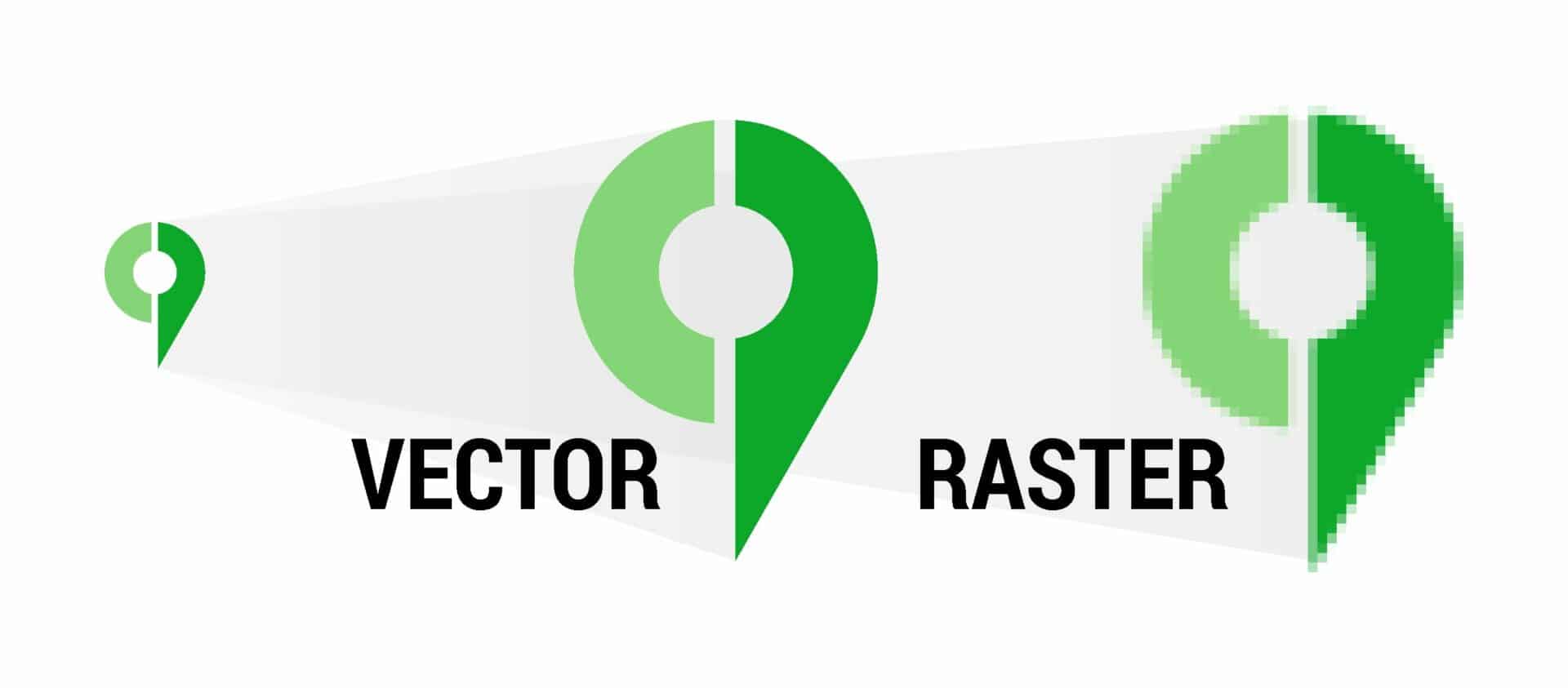In the vibrant realm of visual communication, graphics play a pivotal role and exist in multiple forms. Among these, vector and raster graphics prominently stand out.
Vector graphics weave images through intricate mathematical equations, while raster graphics use a pixel grid to construct images.
Comprehending the contrast between vector and raster graphics is a cornerstone for anyone interacting with digital images. Within the scope of image compression, this knowledge is especially vital to optimizing image quality and storage.
This article offers a comprehensive guide, unfolding both graphic types’ features, strengths, drawbacks, and methodologies for creation and editing.
Whether you’re a seasoned designer or a newcomer dipping toes into graphic design, this write-up will provide you with the foundational understanding required to effectively maneuver vector and raster graphics.
Key Takeaways
- Vector graphics use mathematical equations and are resolution independent, making them ideal for creating logos, illustrations, and designs that require accuracy and precision.
- Raster graphics use a grid of pixels and excel at creating photorealistic images with intricate details like texture and shadow, making them ideal for photo editing software.
- Vector graphics are smaller in file size and can be resized without losing quality, making them useful for large format prints, while raster graphics tend to be larger in file size and can become distorted or pixelated if enlarged beyond their original size.
- Understanding the strengths and weaknesses of vector and raster graphics is crucial for making informed design decisions, and choosing the appropriate type of image depends on the specific needs of each project.
Definition and Characteristics of Vector Graphics
Vector graphics are defined as computer-generated images that consist of points, lines, curves, and shapes based on mathematical equations rather than pixels. They are resolution independent and can be scaled without losing quality or becoming pixelated. Vector graphics create smooth lines and curves which result in clean-cut edges that provide a professional look to the image.
Unlike raster images, vector graphics are not made up of individual pixels but instead use precise mathematical equations to define their shapes. This makes them ideal for creating logos, illustrations, and other designs that require accuracy and precision. The file size of vector graphics is also smaller compared to raster images because they only store the mathematical data used to create the image.
One of the main advantages of vector graphics is their scalability. They can be resized without losing quality or becoming pixelated which is particularly useful when creating large format prints such as banners or billboards.
However, vector graphics may not always be suitable for certain types of artwork such as photographs which contain intricate details that cannot be easily represented by mathematical equations. Despite this limitation, vector graphics remain an essential tool for designers due to their flexibility in design and ease of editing.
Advantages and Disadvantages of Vector Graphics
The efficiency and precision of digital images can greatly impact their functionality in professional design applications. Vector graphics, as opposed to raster graphics, offer a number of advantages that make them ideal for certain types of designs.
For example, vector graphics can be scaled up or down without any loss of quality or resolution. This makes them particularly useful for logos and other graphic elements that need to be resized for different applications.
Another advantage of vector graphics is their ability to create complex shapes with clean lines and smooth curves. This is because they are created using mathematical equations instead of pixels, which means that they are not subject to the same limitations as raster images. Additionally, vector graphics are typically smaller in file size than raster images, which makes them easier to share and store.
However, there are also some disadvantages associated with vector graphics. One common issue is that they may appear too mechanical or sterile compared to hand-drawn illustrations or photographs. Additionally, while vector graphics can be used to create intricate designs with precise lines and shapes, they may not be as effective at conveying textures or shades of color as raster images.
As such, it’s important for designers to choose the appropriate type of image based on the specific needs of each project. Creating and editing vector graphics requires a specialized software program like Adobe Illustrator or CorelDRAW. These programs allow designers to draw shapes using tools like the Pen tool and manipulate anchor points to create complex paths and curves. By understanding how these tools work together with the principles behind vector art creation, designers can produce high-quality digital illustrations that meet their clients’ needs without sacrificing style or creativity.
Creating and Editing Vector Graphics
Exploring the intricacies of digital design software can greatly enhance a designer’s ability to create and edit precise vector graphics. Vector graphics are created using mathematical equations rather than pixels, which allows for infinite scaling without losing quality.
Here are some basic steps to creating and editing vector graphics:
- Choose your design software: Adobe Illustrator is the industry standard, but there are many other options such as CorelDRAW and Inkscape.
- Create your shapes: Use the shape tools (rectangle, ellipse, etc.) to create your basic shapes, then manipulate them using the selection tool and various transform functions.
- Add color and texture: Use fill and stroke options to add color to your shapes. You can also add gradients or patterns for additional texture.
- Edit as needed: Vector graphics are easily editable, so you can make changes at any point in the process.
Creating vector graphics involves choosing a design software, creating shapes using shape tools and manipulations with selection tools, adding color/texture through fill/stroke options/gradients/patterns; it is easy to edit these designs even after creation.
The next section will explore raster graphics’ definition and characteristics in contrast with vectors without skipping a step.
Definition and Characteristics of Raster Graphics
Digital images created using a grid of pixels have unique characteristics and limitations that can evoke frustration or creativity from designers. Raster graphics, also known as bitmap images, are composed of tiny squares called pixels that determine the color and tone of each point in an image. The resolution of a raster graphic is determined by the number of pixels per inch (PPI) or dots per inch (DPI), which affects its clarity and sharpness.
To better understand raster graphics, it’s important to explore their defining characteristics. In the table below, we compare vector and raster graphics in terms of file size, scalability, editing capabilities, and typical use cases. While vectors are ideal for high-quality printing and resizing without loss of quality, raster graphics excel at creating photorealistic images with intricate details like texture and shadow. However, they require higher resolutions to achieve similar levels of detail as vectors.
Despite their advantages in certain contexts, raster graphics do have some notable disadvantages. One major concern is pixelation or blurring when scaling up an image beyond its original resolution. Additionally, raster files tend to be larger than vector files due to their reliance on individual pixel data rather than mathematical equations. This can cause slower load times for web pages or storage issues on smaller devices like smartphones. Nonetheless, understanding these pros and cons is crucial for making informed decisions about which type of graphic to use depending on the project’s specific needs.
While raster graphics offer unparalleled realism in digital artistry with its ability to capture fine details such as textures and shadows through pixels’ manipulation; it also comes with limitations such as blurred/pixelated edges when resized beyond original dimensions or file sizes that can affect loading time on websites or storage space availability on devices. Nevertheless; knowing these pros/cons helps designers make informed decisions based on project requirements between vector/raster formats for achieving desired results effectively without compromising their quality standards nor efficiency goals.”
Advantages and Disadvantages of Raster Graphics
Examining the advantages and disadvantages of using pixel-based images allows for a comprehensive understanding of the potential limitations and benefits they offer in various design projects.
One key advantage of raster graphics is that they are highly detailed, allowing for intricate designs to be created with precision. Additionally, raster graphics offer greater flexibility when it comes to editing individual pixels, making them ideal for photo editing software.
However, the downside of using raster graphics is that they can quickly become distorted or pixelated if enlarged beyond their original size. This means that raster graphics may not be suitable for larger formats such as billboards or posters.
In addition, because each pixel contains color data, large file sizes can become an issue when working with high-resolution imagery.
Despite these limitations, raster graphics remain a valuable tool in digital design. By understanding their strengths and weaknesses, designers can make informed decisions about when to use them and how best to incorporate them into their work. Ultimately, whether vector or raster graphics are used will depend on the specific needs of each project and the desired outcome.

